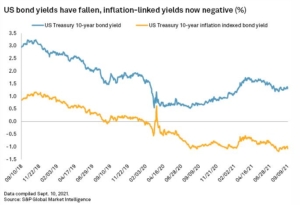What the Fed Decision Means for Markets
What’s in Today’s Report:
- What the Fed Decision Means for Markets
- EIA Analysis and Oil Update
Futures are moderately higher as the rally continued overnight as China injected more liquidity into their economy.
Chinese officials injected another 17 billion yuan into the economy to prevent any liquidity issues, as it’s now clear that Chinese officials won’t allow a disorderly default (and that’s really all global markets care about).
Economic data disappointed as both the EZ and UK flash composite PMIs missed expectations (EZ PMIs fell to 56.1 vs. (E) 58.9 while UK PMI dropped to 54.1 vs. (E) 54.7).
Focus today will be on economic data, specifically the Flash Composite PMI (E: 55.5) and Jobless Claims (E: 309K). Markets will want to see both numbers confirm what the Philly Fed and Empire survey implied last week, namely that the surge in COVID cases was a temporary and limited headwind on the economy. If that’s the case the rebound in stocks should continue.


